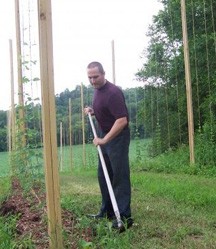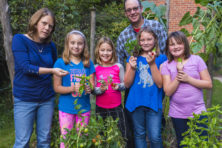Going Small to Grow the Farm
- Share
- Tweet
- Pin
- Share

James Altwies and the team of scientists and engineers at Gorst Valley Hops are using the science of micro-climates to bring hops production back to small Wisconsin farms.
The heartland of American beer once sourced its most important ingredients close to home. In the 1860s Wisconsin’s Sauk County produced 20 percent of America’s hops. By the turn of the century hops production in dairy land was all but gone.
At Gorst Valley Hops, James Altwies and his team of plant physiologists, environmental scientists, engineers, and horticulturalists are working to bring hops growing back to Wisconsin – one small farm at a time. They’ll be at the Door County Beer Festival in Baileys Harbor June 16 to talk about how they’re using science and a focus on small farms to bring hops home.
“I want to keep it here,” Altwies says, to make it a more authentic product, but also to reinvigorate small farms. The 450 microbreweries thriving in the craft beer renaissance use 5 to 6 million pounds of hops each year, but they’re importing from the Pacific Northwest.
Wisconsin was home to hops at a time when agricultural science was in its infancy. Hops are an extremely aggressive plant that can grow 12 to 16 inches per day and can completely dilute the soil if not well managed, Altwies says.
“These are absolutely voracious plants,” Altwies says. “They require a lot of nutrients and get stressed and diseased easily. In the 1860s we burned out the soil and growing environment quickly, and they haven’t been grown here in significant numbers since.”
The folks at Gorst Valley Hops didn’t set out to become hops experts. They started with the idea of creating a new production and value-sharing paradigm in agriculture, and they wanted to do it in Wisconsin, to revitalize small farms and take agriculture back to sustainable roots. They researched every crop with a value of more than $10,000 an acre.
“We determined that hops is a bit of a sexy product that people will take pride in ownership all the way through the cycle of the product,” Altwies says.
Farmers are drawn to the idea of creating a great crop for a specific product, and in Wisconsin, there are few products that create pride like a great beer.
“We don’t have to create a market for beer production,” he says, “so we decided to focus on beer ingredients. It’s easier to get people interested in and passionate about growing beer ingredients than wheat or corn.”
Altwies, a horticulturalist who has studied high value crop production for 15 years, will preach at length about the fallacy of the industrial, one-method-fits-all practice of farming if given the chance.
“You don’t get something for nothing,” he says of the high production that mega-farms are able to gain using genetically modified seeds, powerful fertilizers, and pesticides. “That yield is going to require more input – light, airflow, nutrients. We as a people have to get away from that way of thinking. We need to be thinking more about the cyclical nature and the microenvironment on a farm. Too many people are saying ‘if I don’t have what I want, I’m either going to genetically modify it or put so much energy into what I can get out of these plants.’ People aren’t thinking about whether we should.”
He’s now trying to use science to make agriculture work on a small scale, focusing not on copying the growing practices of the Northwest or Europe, but on tailoring production techniques to each individual farm.
“We know enough to know that taking European styles and copying it here is not a good idea,” Altwies says. “They have a different climate, different soils, different test loads. We’re looking at it from the energetic, scientific sort of way. Take a group of farmers and ask them why they do something a certain way, and 9 times out of 10 they say, ‘well that’s the way we’ve always done it.’”

Gorst Valley is finding new solutions.
“We look at each individual grower and design a trellis and production system that minimizes disease,” he says. “We create varieties specific to that farm’s micro-climate.”
By going small and focusing on niche products with high value, Altwies believes we can not just help small farms survive, but make them attractive, lucrative enterprises.
“People say we have got to get closer to our food. Well, that sounds great at the cocktail party, but it’s hard to do,” he says. “We’ve created a value-sharing program that makes it worth the effort of the farmers. Most farms get 5 – 15 percent of the value of the crop they grow. Well, at Gorst Valley we provide the science, but our farmers on average get 70 percent of the value of the sale.”
It’s accepted wisdom that in our society the consumer has to drive change in the marketplace. Altwies says it’s a nice thought, but convenience is always going to come first, and change won’t happen in consumer choice until there’s a serious problem with the production system. His team is trying to lead with science, not consumer choice.
“We can be ahead of the game here,” he says. “Let me show you, Mr. Farmer, that you can do better by staying small if you focus our energies in the appropriate area. Your 40 or 80-acre farm has much more value if you stay small. I’ll do the science so you can focus on growing. At the end, since you took all the risk, you’re going to get the majority of the benefit.
“To keep the value and the quality in the product we need to keep it local.”
Learn more about Gorst Valley Hops is doing that by visiting http://www.gorstvalleyhops.com and make plans to see their seminar at the Door County Beer Festival June 16. Buy tickets at http://www.doorcountybeerfestival.com.

